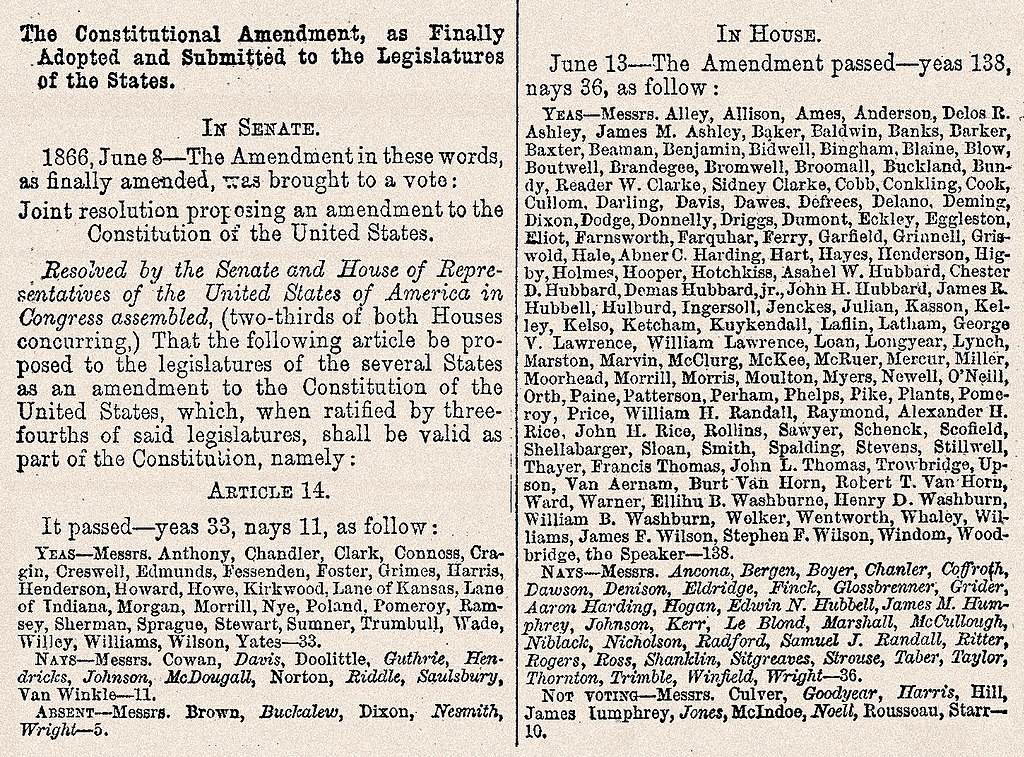
The 14th Amendment turns 150 today. Put another way, the Constitution we live under today is now 150 years old.
‘The Constitutional Amendment That Reinvented Freedom‘- New York Times
Link to US Civitas Facebook Discussion Thread

The 14th Amendment turns 150 today. Put another way, the Constitution we live under today is now 150 years old.
‘The Constitutional Amendment That Reinvented Freedom‘- New York Times
Link to US Civitas Facebook Discussion Thread
:no_upscale()/cdn.vox-cdn.com/uploads/chorus_asset/file/11833599/Foreign_born.jpg)
More on how social identity — here, racial / ethnic identity — can trump (!) ideology and interests.
“This is a dynamic Tesler describes well. “In the post-civil rights era, Democrats needed to maintain their nonwhite base without alienating white voters,” he said. “So their incentive was silence. And Republicans needed to win over white voters without appearing racist. So their incentive was to speak about race in code. The shifts now have made it so Democrats’ incentive is to make explicitly pro-racial equality appeals and Republicans now have an incentive to make more explicit anti-minority appeals.”
Take that idea and extend it out into the coming decades of American politics. The Democratic Party will not be able to win elections without an excited, diverse coalition. The Republican Party will not be able to win elections without an enthused white base. Democrats will need to build a platform that’s even more explicit in its pursuit of racial and gender equality, while Republicans will need to design a politics even more responsive to a coalition that feels itself losing power.”
‘White threat in a browning America‘-Vox News
Link to US Civitas Facebook discussion thread
“Narrated by Bowdoin College Government Professor Andrew Rudalevige, [Founding Principles] provides an introductory overview and basic understanding to American government, but one that is crucial to building citizen-leaders, promoting civic engagement, and working toward the common good.” The Founding Principles website is located here.
Here’s a Table of Contents:
Richard Gardiner, a PhD student in the Department of Political Science at Georgia State University, produced this nice map showing the seven inhabited territories over which the United States claims sovereignty around the world. Those inhabited territories are American Samoa, Guam, Midway Islands, Northern Mariana Islands, Puerto Rico, U.S. Virgin Islands, and Wake Islands. (The uninhabited territories, which are not depicted on this map, include Baker Island, Howland Island, Jarvis Island, Johnston Atoll, Kingman Reef, Navassa Island, and Palmyra Atoll.)

As John Oliver recently discussed on his show, a longstanding question has been over whether or not citizens of the inhabited U.S. territories ought to have the right to vote.
 Fifty years ago today, in Heart of Atlanta Motel v. U.S., the Supreme Court declared constitutional Title II of the Civil Rights Act of 1964, which forbade discrimination by privately owned businesses, such as motels, theatres and restaurants, that serve as public accommodations.
Fifty years ago today, in Heart of Atlanta Motel v. U.S., the Supreme Court declared constitutional Title II of the Civil Rights Act of 1964, which forbade discrimination by privately owned businesses, such as motels, theatres and restaurants, that serve as public accommodations.
That was the title of my Constitution Day address at Georgia Perimeter College last month. The talk centered around four basic propositions. Continue reading
Governing magazine reports:
Takoma Park[, Maryland] recently became the first city in the nation to lower the voting age for local elections to 16. Since the law change in May, 134 voters, ages 16 and 17, registered to vote in municipal elections, and 59 cast ballots in November. That means that roughly 44 percent of registered voters in the under-18 voting bloc participated in the city election.
That’s good news for long-term civic engagement, says . . . [Peter Levine, a professor of citizenship and public affairs at Tufts University], because academic research shows that “voting is habit forming. If you voted in a past election, you tend to vote again.” The question going forward, Levine says, is whether the under-18 voters continue to vote at the same level, or if participation was abnormally high because this was the first time a 16-year-old could vote. When Congress lowered the voting age to 18 in 1972 for federal elections, turnout reached 52 percent for 18-to-24-year-olds, higher than in any year since. Another possibility, Levine says, is that parents and school teachers helped teenagers understand how voting works and what elected city leaders do, which motivated teenagers to vote. [Keep reading]
The Annenberg Center and Game Innovation Law at the University of Southern California have produced a nifty game for exploring redistricting and gerrymandering. According to their About Page:
The Redistricting Game is designed to educate, engage, and empower citizens around the issue of political redistricting. . . . By exploring how the system works, as well as how open it is to abuse, The Redistricting Game allows players to experience the realities of one of the most important (yet least understood) aspects of our political system. The game provides a basic introduction to the redistricting system, allows players to explore the ways in which abuses can undermine the system, and provides info about reform initiatives – including a playable version of the Tanner Reform bill to demonstrate the ways that the system might be made more consistent with tenets of good governance. Beyond playing the game, the web site for The Redistricting Game provides a wealth of information about redistricting in every state as well as providing hands-on opportunities for civic engagement and political action.